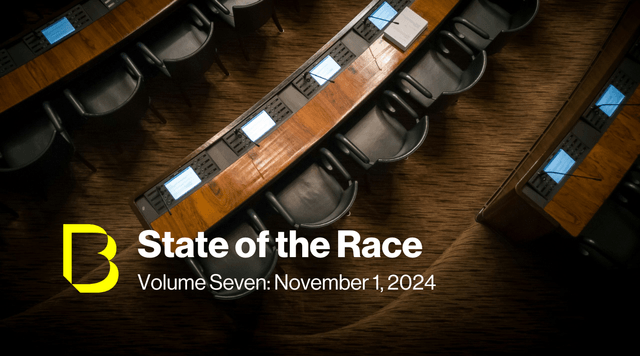Executive Summary
Last night’s relatively cordial vice presidential debate, likely the final debate of the 2024 election campaign, offered voters a closer look at Senator JD Vance and Governor Tim Walz beyond their roles as running mates to former President Donald Trump and Vice President Kamala Harris, respectively. Vance projected confidence, attempting to moderate Trump’s stances on abortion, immigration and guns, but stumbled when pressed on the legitimacy of the 2020 election. Walz, while defending Harris’s record, appeared less steady. Despite some heated exchanges, the debate remained civil and focused on policy. While vice presidential debates rarely sway elections, and polls taken after last night’s debate show little change, this cycle is unprecedented – marked by a change in a party’s nominee, two assassination attempts and only one presidential debate – leaving undecided voters in key swing states seeking substance, which Vance and Walz provided.
A Cordial Debate
The debate, moderated by CBS’s Norah O’Donnell and Margaret Brennan, offered a surprising departure from the usual Trump-era chaos, with Vance and Walz prioritizing policy over personal attacks. Vance appeared polished and comfortable, while Walz initially appeared unsure and defensive before gaining his footing as the night progressed. The two nominees even nodded their heads in agreement on certain aspects of issues such as improvements in gun violence rates, when Walz shared a personal story that visibly moved Vance.
However, both candidates occasionally dodged direct questions and offered incomplete answers. Walz said he ‘misspoke’ when discussing his previous statement that he was in Hong Kong during the Tiananmen Square Massacre, which happened in Beijing, while Vance refused to answer whether Trump lost in 2020. When Vance was pressed on past criticisms he made of Trump, he stated that he was “wrong about Trump,” and blamed Congress for challenges the former president faced during his administration. Additionally, Vance did not back down on his and Trump’s false claims about Haitian immigrants in Springfield, Ohio.
Policy Takes Center Stage
Vance and Walz dove into substantive policy discussions that covered a wide range of issues, from foreign policy, immigration and climate change to healthcare, the housing crisis, gun violence and the state of democracy. Notable developments on policy for each the campaigns included:
- Conflict in the Middle East: Walz condemned Iran’s recent attack on Israel and criticized Trump’s handling of the Iran nuclear deal, while Vance defended Trump’s foreign policy, noting the absence of new international conflicts during his administration, and said he would defer to Israel’s judgement on a retaliatory strike against Iran.
- Climate Change: Vance maintained a skeptical view on climate change and proposed that moving more manufacturing to the United States would help address the issue, pointing to the “cleanliness” of the U.S. energy economy and increasing domestic production of fossil fuels. Walz highlighted the current administration's efforts to increase both renewable energy investments and domestic oil and natural gas production.
- The Economy: In the midst of the International Longshoremen’s Association strike across U.S. coastal ports, Walz challenged Trump’s economic record, highlighting job losses and tax policies favoring the wealthy and expressed support for union workers, while Vance defended Trump’s economic performance.
- Immigration: Vance called for mass deportation, addressing fentanyl imports and building the border wall, and claimed illegal immigration was to blame for falling wages and rising housing costs. Walz criticized the failure to build the wall, reasserting that Trump blocked the bipartisan border bill and stressed the need for legislative action on immigration while preserving migrants' dignity.
- Reproductive Rights: Walz asserted that reproductive rights are a healthcare issue, advocating for returning the decision to women and restoring national access to safe abortion. Vance emphasized the need for Republicans to regain trust on the issue while not providing any specifics as to how, and he claimed to support IVF despite opposing a June 2024 bill that would guarantee nationwide protections for these treatments. Vance made the case that abortion is an issue best handled at the state level and said Trump does not support a national ban on abortion, something Trump emphasized via a Tweet during the debate.
- Gun Violence: Vance linked gun violence to illegally obtained firearms, border security and the mental health crisis, calling for increased school security and empowering law enforcement. Walz supported the Second Amendment but proposed enhanced background checks, red flag laws and research on gun violence.
Impact on Polls Uncertain
Going into the debate, the national polling average showed a close race, with Harris holding a slim
2.6-point lead (48.6% to 45.9%). This tight margin was even more pronounced in the seven battleground states where neither candidate held a lead exceeding the margin of error.
Historically, VP debates have rarely moved the needle. Only one time over the last six presidential elections have national polls moved more than one percentage point after a vice presidential debate and before the next presidential debate. However, this year presents a unique scenario. With no further presidential debates scheduled, this encounter marked the final high-profile opportunity to reach voters before Election Day.
Ultimately, outside of Vance’s refusal to answer a question about the outcome of the 2020 election and Walz’s struggle to clearly discuss his past statements about traveling to China, the debate lacked any major turning points. Both candidates played it safe and effectively carried the mantle of moving toward the center/more centrist messaging to appeal to moderates. Combined with smaller viewership than presidential debates would command and research that suggests the minimal effect that vice-presidential candidates have on voters’ choices, the impact on voters likely remains negligible.
The Sprint to November 5
Election day is just five weeks away and the presidential campaign will enter its final, likely frenzied stage. Here’s what to watch out for:
- Early Voting Trends: Voting is already underway across the country, but early voting turnout appears lower than previous years, and late changes to election rules in several battleground states threaten to increase confusion and delay results.
- October Surprise Potential: The final weeks of an election are always ripe for unexpected events impacting candidates that could shake up the race, as Former Secretary of State Hillary Clinton warned this week. Experts warn of the possibility misinformation and viral stories spreading like wildfire on social media.
- Current Events Cast a Shadow: Ongoing developments in the Middle East, as well as the impact of the coastal port shutdowns and Hurricane Helene, will likely influence voters’ moods. Trump and Harris have surveyed the damage from Hurricane Helene in Georgia and are expected to also visit North Carolina. The storms are also affecting election planning in these key states.
- Tight Race to the Finish: The race remains remarkably tight with the candidates running very close in the battleground states. This will likely continue through election day.
Bottom Line
Both Vance and Walz demonstrated their ability to reinforce party messaging throughout the remainder of the election cycle, using last night’s vice presidential debate to speak to the American moderate. While history suggests that vice presidential debates rarely sway elections, the policies debated hold significant implications for business, particularly in areas such as regulatory changes and housing, tax, healthcare and energy policy. As November 5 approaches, companies need to prepare for either candidate’s victory by having a 360-degree understanding of proposed policy changes and potential effects on priority stakeholders, business partners, operating models and bottom lines.
You might also like
Explore all
Amid disruption, C-suite leaders have the power to steady their workforces

Key learnings from a busy first week of the new U.S. presidential administration

Post-Election Day Analysis

